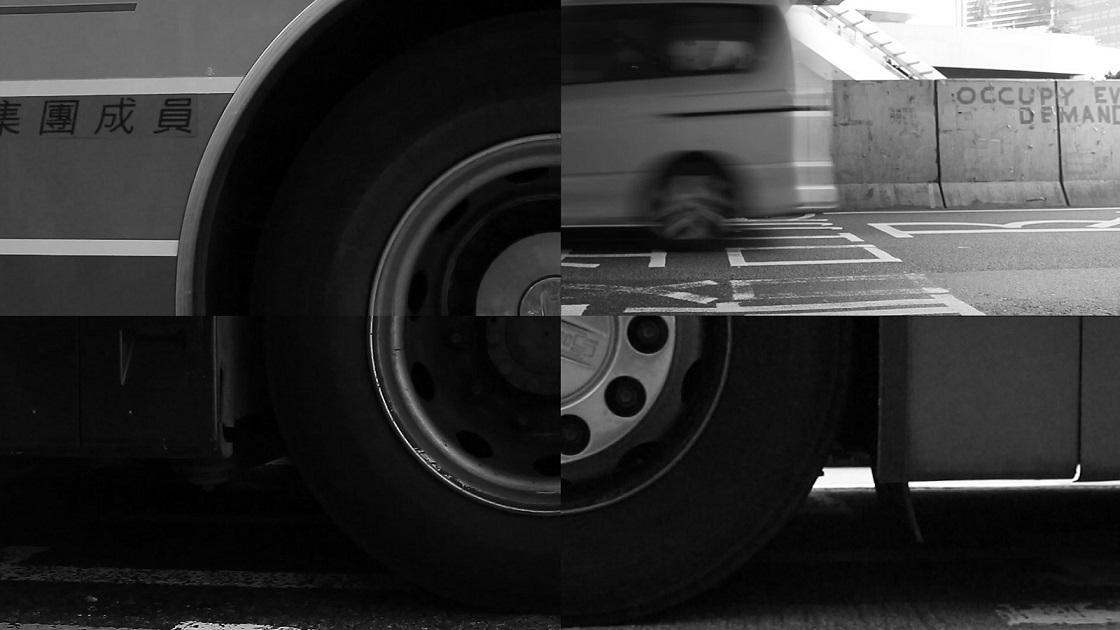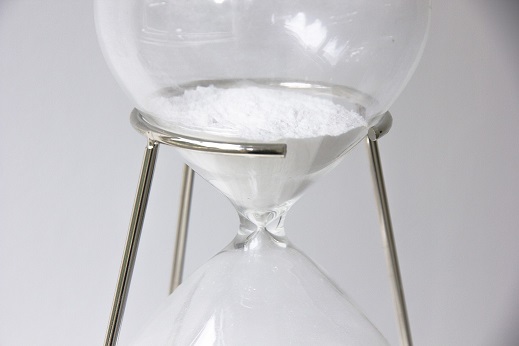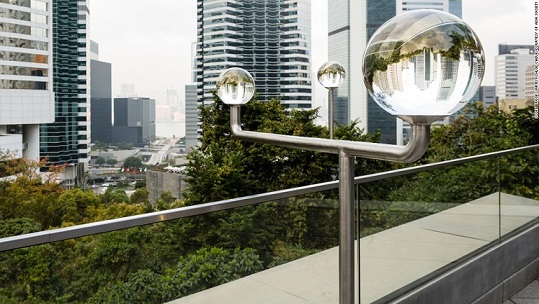Reviews & Articles
Chloë Cheuk
Yang YEUNG
at 6:07pm on 12th February 2018



Captions:
1. The Burst of Pleasure, arduino, processing, custom electronics, balloons, needle, air compressors, valves, 2012
2. ‘She, herself’ exhibition, installation view, 2015
3. Since We Last Met, motor, wood, cups, toothbrushes, 2015
4. I am fine, I am good, I am happy, printer, paper, 2016
5. Waiting For Another Round, wood, projector, 2015
(原文以英文發表,評論卓思潁的作品。)
In precision of tone, sharpness of focus, and integrity of form, Chloe Cheuk’s artistic repertoire over a mere span of five years after her undergraduate education ambitiously touches the danger of desire among a diverse array of other human conditions. In bold, firm, and understated strides, she keeps her self-reflection active so it informs her art making. In this essay, I walk through some of the productive contradictions in select works of Cheuk to propose her commitment in nurturing a reciprocal relation between the artist and art – the artist offers herself to the open-endedness of art while taking its power to crystalize the realities the she encounters. This reciprocal relation is does not privilege the artist’s individualistic intent; nor does it become overly dependent on the artist’s past knowledge of art. It is in reciprocity that Cheuk’s practice grows.
1
In darkness, a video projected onto a roughly one-meter low density polyethylene tubing drew attention; it seized one’s breath. Seen from a vantage point above, bodies slowly walked past. It was not clear in the video who these people were, where they came from, or where they were going. Water droplets hit the tubing intermittently, instantly evaporating. It was only then that one realized the tubing was heated up to a very high temperature: 500 degree Celsius, to be exact.
“Expose” is one of three works Cheuk presented in the solo that concluded her residency at Videotage, Hong Kong, in 2015. The video was made from the window of her old studio on the 12th floor of Foo Tak Building at the junction of Hennessy Road and Morrison Hill Road, where many street demonstrations had passed. The draggy and blurry protesting bodies in “Expose” are in stark contrast to those frequently circulated in the mass media – energized, protruding, sometimes confrontational. “Why do people have to suffer so much?” Cheuk thought out loud. [1] An expression of empathy that may sound familiar in everyday life, but defamiliarised and materialized in “Expose”: the ground is shifted, the figures are compressed, the toil of walking as assertive labor is emphasized. The perplexity arising out of a general human condition acquires magnitude in the installation, increasing the stakes of apathy with the bodies in alliance. [2]
Cheuk reflects upon her practice as having been motivated by “raw feelings”. Instead of creating from materials, she would hold onto a feeling and make a work to carry it. This self-understanding emphasizes the truthfulness and the concreteness of those feelings, and is a compelling way of accessing her art as it is pertinent to her situated self. I find, however, that Cheuk has done much more – in acknowledging her being immersed in such realities, she also takes herself out of them, so that a voice that is not hers produces beauty in brevity and precision. “Expose” is not the only example. In her graduation work “The Burst of Pleasure”, a balloon is installed above a birthday cake with a candle inserted in the middle. The candle is extended upwards with a pin. The balloon is powered by electronics to inflate slowly, until it almost touches the pin. The anticipation of whether and when the balloon will burst builds up to the climax of the balloon actually bursting, but its timing concealed for being designed to do so randomly, once each day. While the experience of time could become oppressive, the playful setting offers relief: a mockery of the sometimes forced and excessive celebratory aesthetics of birthday delights.
In her solo She, Herself (2015), neediness in an ambivalent relation to other human desires is the baseline. [3] Multiple interventions in the apartment-turned gallery showed the texture of the human need to be intimate as well as independent and free – a truth that poet Khalil Gibran has succinctly registered as vital in his relation with his lover. [4] One of Cheuk’s interventions in the show was a video of long hair being blown by the wind, set up on a screen at the entrance of the gallery. I read it in relation to an installation in one room inside the gallery, where a fan stood amidst dry red beans spreading out on the ground. It is not clear from where the beans were thrown and to where the fan is designed to be blowing. It is not clear either if the artist is suggesting any causal relation between the two. The mechanistic nature of the fan and the organic nature of the beans produces oddity, as if haunted by some unknown and residual past lives dwelling the space. To bring the uneventfulness of this stalemate into dialogue with the video, such questions of being and becoming as “Where am I?” (for the lack of scenario in the video) and “From and to which direction am I swept (by the wind)?” arise. An unnamable discomfort lurks in the air.
Another installation in the show entitled “Since We Last Met” sets up toothbrushes in two cups. One cup is stationary while the other rotates. The bristles could touch, slowing down the rotation, but eventually overcoming the friction to turn again. Longing while needing belonging, staying while needing moving – they tell of a common human struggle in intimate relationships. In all, the solo was choreographed around contours of difficult human realities, in touch with what language could yet articulate.
This is why the intelligent finish of each one of her works could be deceptive: clarity of Cheuk’s artistic language makes it tempting for one to say one “gets it”. But when the works are regarded as in relation to each other, it is much harder to give closure too soon. In an ongoing volatility, her corpus presents more intertwined worlds than a single idea of emotion (and in the routinized and overly simplified understanding of emotion as in a polar opposite relation to rationality) could capture.
If Cheuk was making art to lend expression and relief to her emotions, she has done so by regulating idiosyncrasy without losing touch of sensuality. Her concerns are effectively communicated through exercising a formality similar to the way Roland Barthes distinguishes between “writing” and “style”. Writing, he says in Writing Degree Zero is a relation between creation and society, through which the artist makes clear his or her individual stance. It is a “compromise between freedom and remembrance”. [5] “Style” on the other hand is “an autonomous language which immerses itself only in the author’s secret, personal mythology”; there is always “something raw” about it, and it is “the product of impulse, not intention, it is like a solitary, vertical dimension of thought.” I have doubts about Barthes’ idea that style has an origin free from social influence and as if this “personal mythology” is always transparent to the self (which, instead, may take a lifetime to unravel). But knowing the choices the artist makes on and in between the two nexuses could offer the potential where singular and general human experiences could be united.
2
Cheuk has made other significant aesthetic choices that are telling of the transformative energy art has produced for her and she has produced of art. I would like to focus on the recurring phenomena of slowness and roundness to show how her practice has been growing into different kinds of strength.
First, on slowness. “Sometimes Hot but Feeling Cold” (2014) is a sonic kinetic installation. A tungsten light bulb swings slowly away from a speaker playing the sound of a moving fan. It is as if the bulb is being blown by wind. The slowed motion is not unlike The Burst of Pleasure, in sharing a repetitive pulse, a disciplined breathing-in, breathing-out. Cheuk’s artistic statement for this work speaks of her intention to also set up the contradiction between the heat produced by the tungsten filament and the coldness of the artificial environment – the routinely and sometimes excessively air-conditioned indoor spaces in Hong Kong, for instance. I find the artist’s imagination of this ”eerie order” [6] more prominent in the artificiality of the movements of the sound, object, and light, than the change of temperature. The slowness is precisely the artificiality in its awkwardness, defying the built-in function of an ordinary object. It is also in this that the artist’s interest in a physical phenomenon of and against nature becomes apparent. In this work, the artist’s struggle between conversing with nature and appropriating nature with technology for mastery and control is prominent yet unresolved. Gradually, the color and emphases of this struggle are to change.
When studying in Montreal for her MFA, Cheuk presented “I am fine, I am good, I am happy” (2016). This is an installation of an ink-jet printer high on the wall. The printer spills out a long scroll of paper on which the lines “I am fine”, “I am good”, “I am happy” are pre-printed. The roughly four-meter scroll is looped back into the printer, never ending, not going anywhere. The installation produces an anomaly out of ordinary objects of daily life. Compared to “Sometimes Hot but Feeling Cold”, however, this work makes the artist’s stance on the alienation between technology and human emotions more succinct. The slowness is in the dullness of machines and in what they have (don’t have) to say about the emotional state of whoever is using them – the “self-statement” becomes a self-alienated or self-denying (self-denied) statement. Both works are absorbing for the seer, but the more recent one shows a heightened sensitivity to the human corporeal relation to the machine and the dimension of this relationship. Cheuk’s practice is moving towards more intellectual depth without abandoning singular, individuated experiences.
Now and Then, borax crystal, a broken mobile screen, 2017
From engaging with slowness as a kind of slowing down by degree, Cheuk most recent work “Now and Then” (2017) gives a different account of slowness. [7] A screen of a damaged mobile device is placed into borax saturated water. Crystals were formed on the surface of the screen, and accomplished the effect the artist envisioned after ten trials. She spoke of it as entirely new in her practice because it was motivated by engaging with the objective world that she could observe rather than by prying into her feelings. I think it also registers her confidence in the change of artistic language that seeks to do away with electronics and digital technology as tools. It is also a language that recedes and settles into understanding natural processes and laws while technology becomes an idea to think with. The speed of mobile devices that have made their signatures is now completely disarmed. It would have taken much reflection for the artist to be able to move from the self to the phenomenon – she is slowing herself down and trying ways of thinking that does not only pierce, but rather, elongate and spread out to form planes, complicating the verticality of her thinking. This brings me to the last point about her interest in roundness, which, like slowness, registers the transformation she is going through from focusing on her life time (as biographical time) and social time to envisioning the future. 
Please Take Your Time, hourglass, metal, grained tablets, prescribed label on plastic bag, 2017
To read “The Burst of Pleasure” again, roundness serves parody. In “Waiting for another Round” (2015), a video showing the close-up of vehicular wheels in Admiralty, Causeway Bay, and Mongkok where the Umbrella Movement took place in 2014 registers a critique: the uneven distribution of the right of movement in public space that is totally urbanized, bereft of human bondage. In “Please Take Your Time” (2017), the roundness of the hourglass holds literally the crushed anti-depressant drugs defining the artist’s life, and symbolically, the condition of healing in a future that remained uncertain. In the attention Cheuk gives to what is round (as an image) and the spherical (as a sculpture or object), she discerns without discriminating the differences in contexts and keeps multiplying their iterations.
“…Until I am found” (2017) is a significant expansive step. [8] An outdoor sculpture of two glass balls of different sizes with a globular lens in between, one needs to move the lens nearer to or away from the glass balls, (which Cheuk calls “globes”), to find one’s view. Without using electronics, the sculpture’s movement relies entirely on the viewer’s own hands to move the lens backward and forward in a straight line, hence, constrained, but also open for the choice of speed and duration. A view could always be found, but it makes no promise of clarity. This goal of achieving the asynchronous is registered in Cheuk’s artist statement, “the reflected cityscape would be altered from an upright but blurry image to an inverted yet clear view.”

…Until I am found, stainless steel, glass, concrete, 2017
I find Cheuk’s particular attention to roundness in “…Until I am found” new to what she had done before. With this roundness, she lets go of any imperative to make claims. Instead, the work conjures a dimension of liminality that keeps changing. Instead of aiming for symmetry and perfection, Cheuk’s ambition seems to be in the imperceptible, even infinitude. One might be in bliss, deriving pleasure from the dream of clairvoyance and the reality of the human capacity to aspire to a change of focus. It is a work that envisions a future.
Writing about how the mind moves in the activity of imagination, Elaine Scarry notes that “Circles and spheres move so easily in the mind that the motions of wheeling, pivoting, rolling, arcing are picturable even when what pivots or wheels is quite heavy, like a man, a loaded wagon, or a plump sparrow.” [9] If “…Until I am found” is a manifestation of the way the artist’s mind moves, it may be registering another plane in her search of time – the need to gaze outward, to be detached from the weight of personal history, and to make a different present, lived time. By putting herself in the light of a larger world of possibilities, “…Until I am found” admits change as positively constituting life without having to coerce any particularly secure future.
Alternatively, “…Until I am found” could also be read as an intervention in urban space. Against its background of a glass and metallic jungle, it conjures a quiet mockery on the phallocentrism of the skyward structures the viewfinder shrinks, reverses, and brings close to the body. With the deliberate glitches for the hand to move the focus, the work lives up to her words, “I think imperfection is more attractive.” [10]
As in “Now and Then”, “…Until I am found” is rid of electronics and lends attention to natural laws of light and the mediation of its motion. Of this work, Cheuk spoke of an ideal world that was “over here”, she pointed to the back of the left side of her head in an interview. I think the idea of “ideal” needs to be made clearer. In analyzing walking and thinking as movement, Tim Ingold (borrowing from Kenneth Olwig) distinguishes between connecting with the world in the utopian, dystopian, or topian ways. He says that the “topian” is neither utopian which is a narrative of progress, nor dystopian, a narrative of fragmentation. It rather refers to “practices of dwelling and the circuitous movements” as ways we connect with the world.” The topian has always already arrived in Cheuk’s works; it is part of the struggle. [11]
3
Cheuk’s trust in aesthetic choices reminds me of Ursula LeGuin’s poem “The Dream Stone”. I quote its opening lines:
Seeking the knowledge I only know I lost,
I take the intangible into my hand
to pay the price of what is past all cost.
It is a grey stone lying on my palm.
Its even substance deepens to a mist
and in it moves a fire, contained and calm,
as in a cloudy opal or a hummingbird’s
rose-turquoise breast […] [12]
Seductive without being sensational, intimate without being idiosyncratic, Cheuk’s works keep turning corners and confronting shadows. In them lies a composure that rests in art that simultaneously steadies and invigorates the urgency to raise questions. Immersed in cascades of perplexities, they have not failed to enchant. So much is still in the making.
Notes:
[1] From an interview I conducted with the artist at Cheuk’s studio, MakerBay, Yau Tong, Hong Kong, on April 16, 2017.
[2] Judith Butler. 2011. “Bodies in Alliance and the Politics of the Street”. www.eipcp.net/transversal/1011/butler/en(accessed August 20, 2017)
[3] The solo took place at Things That Can Happen, Shamshuipo, Hong Kong, August 1 – 23, 2015.
[4] Maria Popova. “The Difficult Balance of Intimacy and Independence: Beloved Philosopher and Poet Kahlil Gibran on the Secret to a Loving and Lasting Relationship”. www.brainpickings.org (accessed August 20, 2017)
[5] Roland Barthes. Writing Degree Zero. Tr. Jonathan Cape Ltd.. New York: Hill and Wang. 1967:22.
[6] www.chloecheuk.com (accessed August 20, 2017)
[7] Presented in Cheuk’s solo Sides Effects at DIENSTGEBÄUDE Art Space Zürich, June 1 – July 1, 2017.
[8] Presented in the exhibition Breathing Space, Asia Society Hong Kong Centre, March 12 – August 13, 2017.
[9] Elaine Scarry. Dreaming by the Book. Princeton: Princeton University Press. 1999: 203.
[10] As Note 1 above.
[11] Ingold, Tim. Lines: a brief history. New York: Routledge. 2007: 167.
[12] Ursula K. LeGuin. Late in the Day: Poems 2010-2014. Oakland: PM Press. 2016:29.
First published in Art Review Hong Kong Issue 3 in December 2017 by Art Appraisal Club, Hong Kong
